What About Meth? The Devil's Drug
With such focus on fentanyl, many have forgotten about crystal. Teun Voeten reminds us in his riveting new book, including this brutal excerpt from Skid Row.
Para leer en español click aqui.
This post includes a lot of great photos that may be truncated in your email; if so you can see it in full on the website at www.crashoutmedia.com.
The United States has suffered the worst overdose crisis in its history, with over 100,000 fatal O.D.s for several years running (until a drop last year). While the focus has rightly been on fentanyl, found in the majority of victims, it can be forgotten that crystal meth is still a huge part of the problem. Teun Voeten, journalist and friend of CrashOut, trod the globe from meth labs in Michoacán to rehabs in Kabul digging deep into meth, which he calls “The Devil’s Drug.” He has put his research into a riveting new book with that name, which you can find here.
Teun is a photo journalist with a mountain of cracking meth pictures and he let us show a sample here shot in a variety of locations. But he is also a damn great scribe, mixing immersive reporting with well-sourced analysis. I was honestly spoiled for choice as to which chapter to reproduce, whether one on meth in his native Holland or in Prague or on the bizarre history of meth. But I settled on Skid Row.
Some may not like Teun’s cutting description of homeless meth users on the dirty streets and he cuts into a febrile debate about drug policy and harm reduction. I may not agree with everything he writes (and I need to report more on drug use and homelessness in the U.S. myself to even figure out what I think). But Teun has spent years among front line users and genuinely tries to make sense of their painful situation. I think this excerpt offers one of the most vivid and powerful descriptions anywhere of street drug addiction in twenty-first century America. IG
Skid Row, Downtown Los Angeles - From Winos to Crackheads to Tweakers
By Teun Voeten
Los Angeles is the epicenter of the current homeless crisis festering in the United States. Rising housing costs, illegal migration, and the COVID-19 crisis have led to the highest number of homeless people in the country in 10 years: 600,000 people live on the streets, according to figures from the U.S. Department of Housing and Urban Development, HUD, from 2023. Of these, 65,000 reside in Los Angeles. They are camping out in tents and flimsy structures all over town, at the exits and entrances of the freeways, under most bridges, in the upscale Echo Park, at the boardwalk of Venice Beach. Skid Row is ground zero for the homeless crisis. This area in central LA, where drifters used to crash in cheap flophouses, has grown into a gigantic tent camp covering 60 city blocks, where an estimated 8,000 homeless people forage in garbage-strewn streets. A few blocks away is Broadway with its once stately theaters that hosted celebratory premieres in the glory days of Hollywood. The Bradbury Building, where the legendary scenes from the science fiction film Blade Runner were shot, is also on Broadway. The cinematic nightmare seems to have become reality now with thousands of outcasts scurrying against a backdrop of gleaming skyscrapers. The worst cases are severely deranged psychiatric patients who crawl naked on the street. They relieve themselves where it is convenient and yell at the air while making savage gestures with their fists.
Other homeless people sleep on the sidewalk in a cramped position in the blazing sun. A pungent smell of urine and weed, recently legalized in California, hangs in the air. Most homeless people just sit and stare apathetically in front of them with empty and hollow eyes, under the influence of the many drugs that are widely available here. Crack was once the drug of choice for the down-and-out, with a street price of $3 per hit within reach of any pauper. Now that dubious honor has been taken by crystal meth, which has become drug numero uno for the absolute underclass.
“It’s Chris versus Crack, and Chris is winning,” Skid Row resident Holly explains to me. The difference is that crack’s high only lasts 15 minutes. With a portion of crystal meth, you are all set for at least half a day. An attractive price-quality ratio. Holly continues on the danger of meth. “With crack you check out in three days. Meth will never let you go.” Holly knows what he is talking about since he enjoys a nice hit of crack once in a while. He loves metaphors and is a poet in his own way. “Crack is one shoe on, one shoe lost. Crystal meth is both shoes gone.”
An estimated 80 percent of Skid Row residents use crystal meth. A user portion is $5, explains Scotty, a heavy user. He shows me how easy it is and takes me to his dealer to score a nickel. This is slang for “buy a five-dollar serving of drugs.” He calls out a name at a tent at Crocker Street, close to where Holly has his base. An answer comes from the tent and Scotty slides five dollar bills through a hole in the front canopy. Not much later a man appears from the tent. He quickly puts some white crumbs packed in a piece of creased wrap on a plastic chair outside. Scotty takes his merchandize. The entire transaction took less than 20 seconds.
Many crystal meth users finance their own consumption by dealing, so through a snowball effect, meth use is spreading like wildfire. Scotty has a different buisness model. “I slam three dimes a day,” he explains. A dime is slang for $10, so Scotty means he shoots up meth worth $30 a day. Scotty goes to the needle exchange on Fifth Street at 8:30 every morning to get clean syringes. The name needle exchange suggests you can swap a dirty syringe for a clean one, but it works differently. The volunteer who works there knows Scotty by name and hands him a brown paper bag. Scotty still has the decency to find a quiet spot for his shot; but many clients simply shoot up and smoke on the sidewalk in front of the organization.
Down a small alley, Scotty shows me the contents of the bag: 40 syringes, rubbing alcohol, and tourniquets to tie off your arm, which will make your vein swell and make it easier to inject. Scotty uses four or five syringes a day. He resells the rest for $1 each to other users. This will pay for his own use. He also gets many bottles of free water that organizations and volunteers hand out to the homeless. He sells three bottles for $1 to shady shops that resell each bottle for $1. Micro-scale narco-capitalism at work.
Scotty’s meth use goes back a long way. He used to be in the army and was stationed in Germany. There he made his own meth using the Czech method, with ephedrine, iodine, and phosphorus. He was making thousands of extra deutsche marks a month and proudly brags how he was never caught. Scotty had long-term plans and was smart enough to save up his illegally amassed funds. Once back in America, he started a firm selling construction tools. He managed to control his crystal meth addiction, according to his own account by drinking a case of beer a day. His life began to unravel however when his wife developed cancer and chemotherapy failed. His drinking went out of control, he lost his business, and started taking crystal meth again. After a short stay in in the psychiatric ward of the Los Angeles county jail, he washed up on Skid Row three years ago.
Previously, he must have been a big, huge, strong guy. Now he has scars on his arms from shooting up and he is all skin and bones. Scotty used to take heroin, but he stopped “thanks to crystal meth.” Initially he smoked meth, but he learned slamming from a female addict and found that it gives a much more intense experience. “If I inject 10 dollars, worth, I spontaneously have an orgasm,” he says, beaming. “Awesome.” He has bloody scabs on his head, injuries sustained in fights. Heavy wrinkles pierce his face and his last, blackish tooth protrudes from his mouth. He admits he suffers from tweakers, the imaginary creatures that meth addicts think are crawling under their skin. He also has the injuries typical of heavy meth users and sores on his arms that have been scratched open. “Every dealer tries to sell the strongest stuff. They also mix the meth here with a tiny bit of fentanyl to make it even stronger,” he adds.
In the 1990s, I lived for months in a colony of underground homeless people in New York and wrote my book Tunnel People. Crystal meth was not yet in vogue: crack was the drug of choice for the poor. A portion back in those days was available for $3 and was, in fact, more readily available and cheaper than marijuana. The use of crack was widespread at that time. But it was rare to see people using it openly. To smoke, some people went into the tunnel, others crawled into an empty building, an abandoned dark porch, or found a place behind a garbage container in a back alley.
I first saw Skid Row in 2000 when I was visiting a friend in Los Angeles. She took me in her car and we toured the area for 15 minutes. I was shocked that this existed in a wealthy country, but at the same time became fascinated. A few years later I had the chance to satisfy my curiosity. In 2003, I became artist-in-residence at the swanky California Institute of the Arts, located in Santa Clarita, a super-clean, boring bourgeois suburb that could have served as a model for The Truman Show’s town of Seahaven. CalArts was a half-hour drive from downtown Los Angeles.
The photo project I started was of course about Skid Row. I drove there every day and sometimes took up residence in a cheap hotel where other local residents stayed. I befriended Jimmy, a hardcore alcoholic with a savage beard who drank four liters of malt liquor a day, and Russell, a former special-effects man who was now addicted to heroin and had lost his job in Hollywood. Jimmy and Russel were my guides and showed me the neighborhood.
The difference between Skid Row then and Skid Row now is that the area with tents was a lot smaller in 2003, I estimate half of what it is now. Crystal meth hadn’t made an appearance yet. The drugs of choice at the time were alcohol and crack. And more importantly, most homeless people did not use openly on the street. Jimmy very discreetly drank his large bottle of beer from a brown paper bag. Russell sought hidden spots and preferred to do his shot of heroin in porta-johns that the city had placed everywhere.
These days everyone at Skid Row smokes meth and crack in public without embarrassment using the typical glass pipe. People shoot up right in the open on the sidewalk, in front of pedestrians and schoolchildren. In 2020, Proposition 47 was passed in liberal California. Shoplifting of goods worth less than $950 was no longer a crime but became a misdemeanor. Also, the use and possession of hard drugs was removed from the criminal record. In the old days, you could be arrested for smoking crack; now the police ignore people doing drugs out in the open. Dealers are no longer bothered.
Proponents argue that the new law no longer criminalizes addicts but rather sees them as patients. Opponents argue that Proposition 47 has removed the taboo from hard drugs and, together with the legalization of cannabis, has caused a huge increase in their use. Author and activist Michael Shellenberger is one of the leading critics of so-called progressive urban policies that actually encourage drug use, poverty, and homelessness. In his book San Fransicko: Why Progressives Ruin Cities, he analyzes what happened with the Tenderloin District. Once, this was a free haven for hippies and gay people. Now it has become a filthy urban zone where impunity and chaos reign and where dealers sell meth and fentanyl to a population of addicts who are dying in the streets. Businesses are closing because shoplifting has become a plague.
“This is a Disneyland for addicts,” explains Pastor Blue, a black man from Atlanta. He is a former drug dealer who also bred pit bulls. After a stint in prison, he settled himself here on Skid Row as a self-proclaimed pastor. Many Skid Row residents have a prison history: one elderly man is even still wearing his brown LA County jail shirt as a badge of honor.
Pastor Blue is one of the rare positive role models on Skid Row: on Crocker Street, a street in the middle of Skid Row with a string of tents on the sidewalk, he has created an enclave with his buddy Holly. There, people can sit quietly on a couch, under an awning, out of the blazing sun. “A refuge, a peaceful place in the midst of this chaos,” he explains. Pastor Blue consults, gives advice, and keeps his place thoroughly clean: he is busy every day with a broom to remove any dirt accumulating on his ministry.
But all around him, chaos and madness reign. Opposite the pastor’s place a large SUV is parked. A black man inside has rolled the window down and smokes a cigarette. He gives me friendly nod and we start to chat. Vemo is his name, he is a veteran. He has no visible booze or drug problem and lives temporarily opposite Pastor Blue in a cheap hotel. “People here are just like talking dogs,” is his harsh verdict. He prefers to watch life on the street from his gigantic SUV. “If they have to take a shit, they just drop their pants in the middle of the street and let everything run. They don’t live, they vegetate.” As Vemo is talking, a woman urinates in the middle of the street. She cleans her intimate parts with water from a bottle and toilet paper, which she throws on the street after use. “At least she cleans herself,” Vemo notes, “but it’s sad how people here degenerate into cavemen.” Vemo came to Los Angeles to sort out the paperwork for his veteran’s benefit. He wound up on Skid Row to save money living in an extremely cheap hotel that is more like a shelter. Once the paperwork is settled, he will leave immediately. He is sarcastic about the aid workers who descend on Skid Row every weekend to hand out food and bottled water. “They have their good deeds registered by photographers they bring along. Liberal Jesus junkies,” he sneers. “Little white girls who think they’re great for handing out bottles of water to black paupers. But everything stays the same on Skid Row. The only thing that changes is the day on the calendar.”
“When I smoke crystal meth, I feel happy,” says Nancy, a black homeless woman. She puffs from a meth pipe and exhales large clouds of white smoke. She claims her use has been constant for three years. Every day just half a gram. Some users can limit their consumption to a gram a week and keep it that way. But most get habituated and wind up shooting or smoking a few grams a day. Nancy sits in an armchair that is placed against a wall, securely enclosed by a sheet of tarpaulin on one side, a tent on the other, and an old piano that faces the street. An old white man with a large white beard, Rodney is his name, plays “Hotel California” on the piano.
On this corner of Los Angeles Street and Third Street, a group of people live together: Rodney, Anthony, and Justin. Rodney was a musician in Virginia. He says the tour bus of his band burned out, with the complete set of instruments. He went broke and washed up in LA. Justin and Rodney found an old piano on Skid Row and dragged it into their corner. Sometimes other homeless people play it, a rare instance of peace and poetry in this filthy and brutal environment.
Justin is a white man in his late 20s. He is addicted to heroin and is trying to kick the habit with methadone. He has two small axes for self-defense and is sharpening them like razors with a whetstone. “I’m happy for an attacker that I never had to use them,” he notes matter-off-factly. Often I see Justin in an armchair, dozing off in a deep sleep—or has he passed out from heroin? Two tents down the block lives Anthony, a black veteran. He used to indulge in meth and coke, but he “got fed up to finance fancy cars from dealers,” he explains. “I decided to keep my money where it belongs. In my own pocket.” Now he works around the corner in a department store as a stock manager. “I don’t like to hang around doing nothing. God gave me a healthy and strong body.” Every day he finishes at six o’clock and buys a can of food for the stray cat the group adopted as a pet.
Anthony doesn’t only care about animals. He has set up an extra tent that functions as a emergency shelter for women, the most vulnerable group on Skid Row. One of the women who regularly comes by is Anna, a woman of Afghan origin with a strikingly beautiful face that radiates dignity and nobility. She uses crystal meth, she admits. Quite a lot. Most of the time when I run into her, it is impossible to have a sensible conversation. One time I see her smearing her legs and arms with a large pot of white wall paint. Then she’s sleeping on a mattress outside by the piano again, all her belongings in a shopping cart. Her hand is bandaged with pieces of cloth. An infection that won’t heal. Rodney tells her she needs to go to the hospital because she might develop gangrene. But she dismisses his concerns and says it is not necessary. A few days later, I meet her again on the spot she usually hangs out. She has painted her face with a silvery makeup. With the tip of a fishing rod, she lifts the veil she has over her head and points to her new boyfriend, a young hippie who sits for minutes like a Buddha in a meditation pose next to her shopping cart on the sidewalk.
Not far away I meet Sunny, a Korean man, at the entrance to the library, sucking on a meth pipe in the shade of a plum tree. “It’s my medication,” he says. Sunny says meth affects different people in different ways. “You have to be able to handle it,” he says. “Just because you’re on drugs doesn’t mean you have to become an animal.” Meth makes him philosophical, he claims. He likes to retire to the library to read. “I meditate and study the world. I am a keeper of the truth. I don’t hurt a fly. I don’t steal or cheat. I am a citizen of this society and wish to be treated as such.”
Sunny may seem like an exception, the fairly functional meth user who reads books in the library to educate himself. But he sells meth to others to fund his own use, this way perpetuating the deadly cycle. He lives a little farther down the road, in a tent opposite the Starbucks on Second Street. Sometimes I walk by there to say hello. One day his tent is gone. I see Sunny sitting on the pavement, bent over, his head in his hands. The Sanitation Department probably threw his entire worldly possessions in a garbage truck when he was out. Sunny is sobbing. He doesn’t look up and doesn’t want to talk about what happened.
Andy Bales is the passionate director of the United Rescue Mission, one of the largest and oldest shelters on Skid Row. In its heyday, it could accommodate a thousand people. The capacity has now been reduced to a third due to the COVID-19 pandemic. Bales is in a wheelchair, he lost both legs. The first amputation was necessary after a staph infection resulting from a cut caused by a shard of glass on the dirty streets of Skid Row. His other leg then became so overloaded that he developed complications and a second amputation was the only solution. “South Los Angeles gangs control the streets here,” say Bales. “They distribute the meth that comes directly from the Mexican cartels. But if you say that, liberals accuse you of stigmatizing the gangs.” It wasn’t just allegations from progressive citizens. Bales was literally threatened by gang members who stood on the doorstep of his mission.
Bales is a fierce critic of city policy to build housing units for the homeless population. Ultimately, of the 10,000 apartments that were to be built, only 800 were delivered at a cost of half a million dollars each. “Anything that doesn’t have granite countertops is unacceptable. Intervening in alcohol and drug abuse is considered by liberal politicians as interfering with privacy. Liberals find shelters inhumane. Yes, shelters are indeed not ideal. But we’re talking about a national humanitarian disaster here. It is just a deadly policy to want to build unaffordable apartments that in reality don’t materialize.”
“This is a crisis like we have never experienced before. A thousand homeless people die every year here in Los Angeles. Heart and vascular disease, traffic accidents, an overdose or hypothermia in the nights that can be freezing cold. Medieval diseases are on the rise. The bubonic plague is here, resistant strains of tuberculosis, hepatitis C, and typhoid. Psychiatric patients roam the streets freely. Gang violence is on the rise. It just can’t go on any longer.”
Thanks to tireless lobbyists such as Bales, the federal government has slowly taken action. In April 2021, they ordered the city council to evict everyone from Skid Row and provide them with housing by October. The city council appealed in July 2021. A year later not had much changed.
I return to Skid Row November 2023 and notice some slight improvements. Most sidewalks close to the city center have been cleaned of tents. The tents on the corner where Rodney, Anthony, and Justin lived have disappeared. Addressing the homeless crisis was an important focus in the campaign of Karen Bass, who was elected late 2022 as the new mayor of Los Angeles. She started operation Inside Safe to move tent dwellers to the many single-room-occupancy hotels (SROs) in the Skid Row area. But the operation is not without hurdles. The biggest landlords of SROs, the Skid Row Housing Trust and the AIDS Welfare Foundation, have struggled to make the nearly 3,000 units they manage safe and livable. Then there are the many problems besieging the homeless. For some people, moving in stable housing is a smooth transition. But for others the ride is bumpy. Drug addiction and mental disorders, exacerbated by years of living on the streets, don’t disappear once you have a roof above your head.
All photos by Teun Voeten and used with his permission, from different locations and dates.
Copyright Ioan Grillo and CrashOut Media 2025


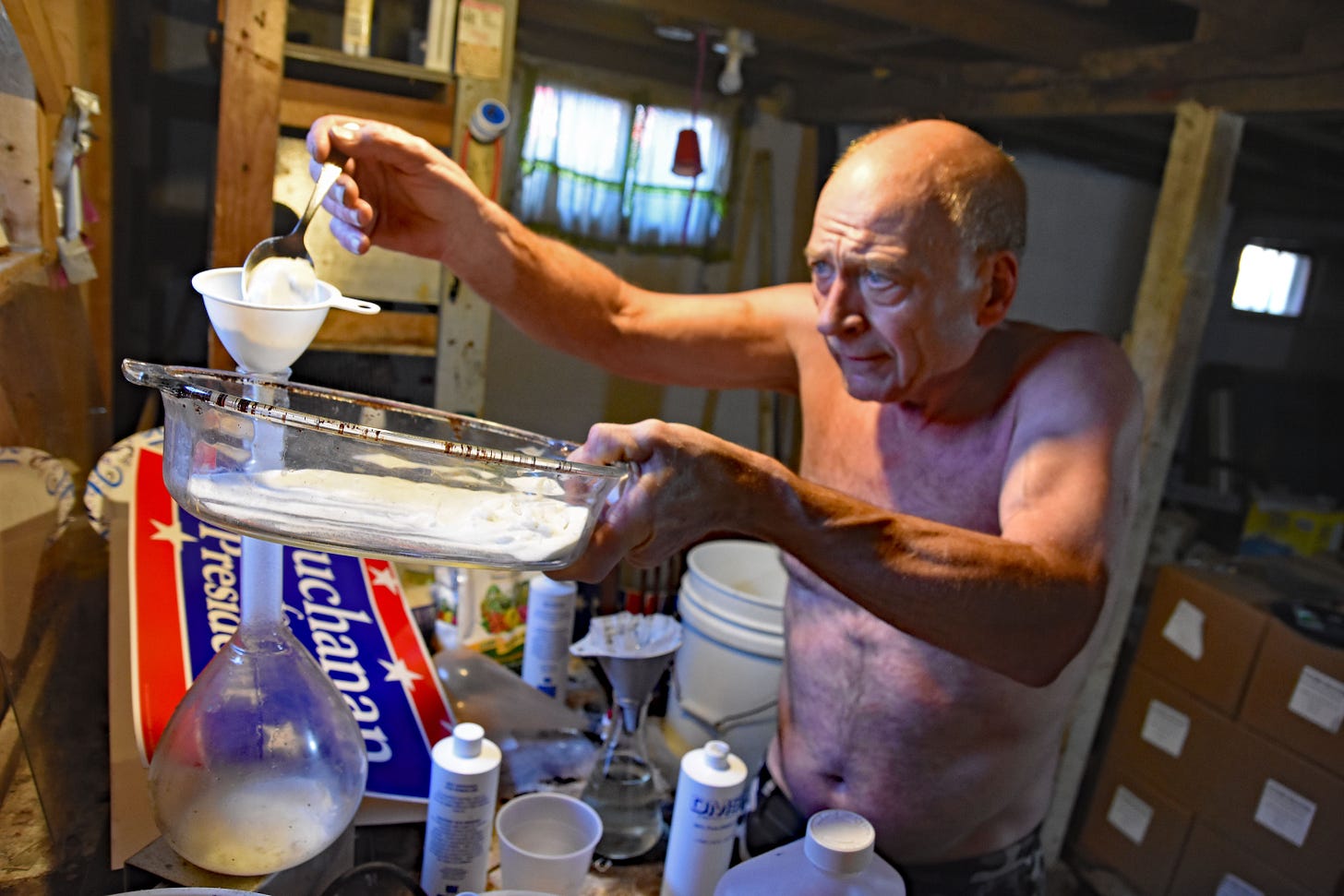

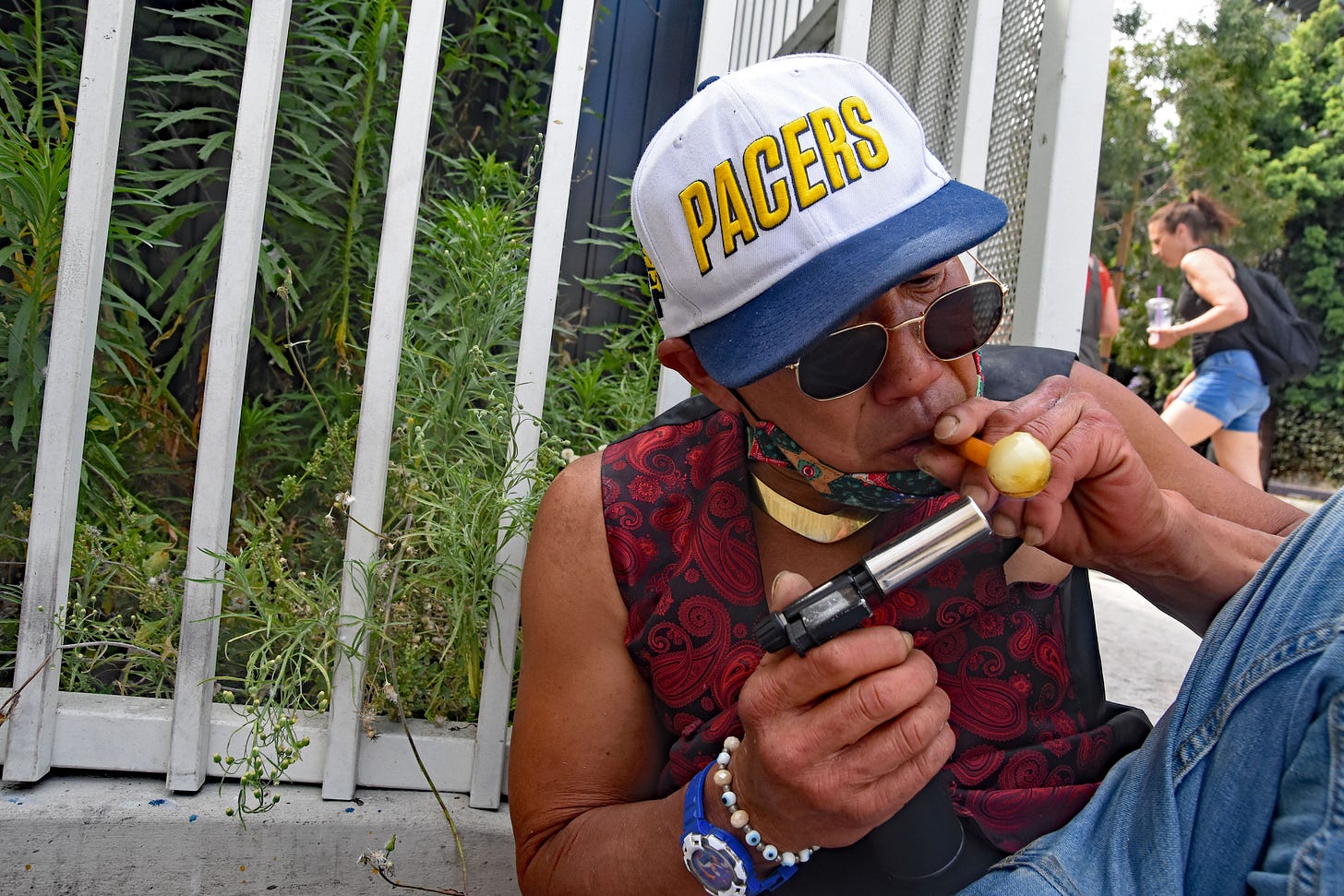
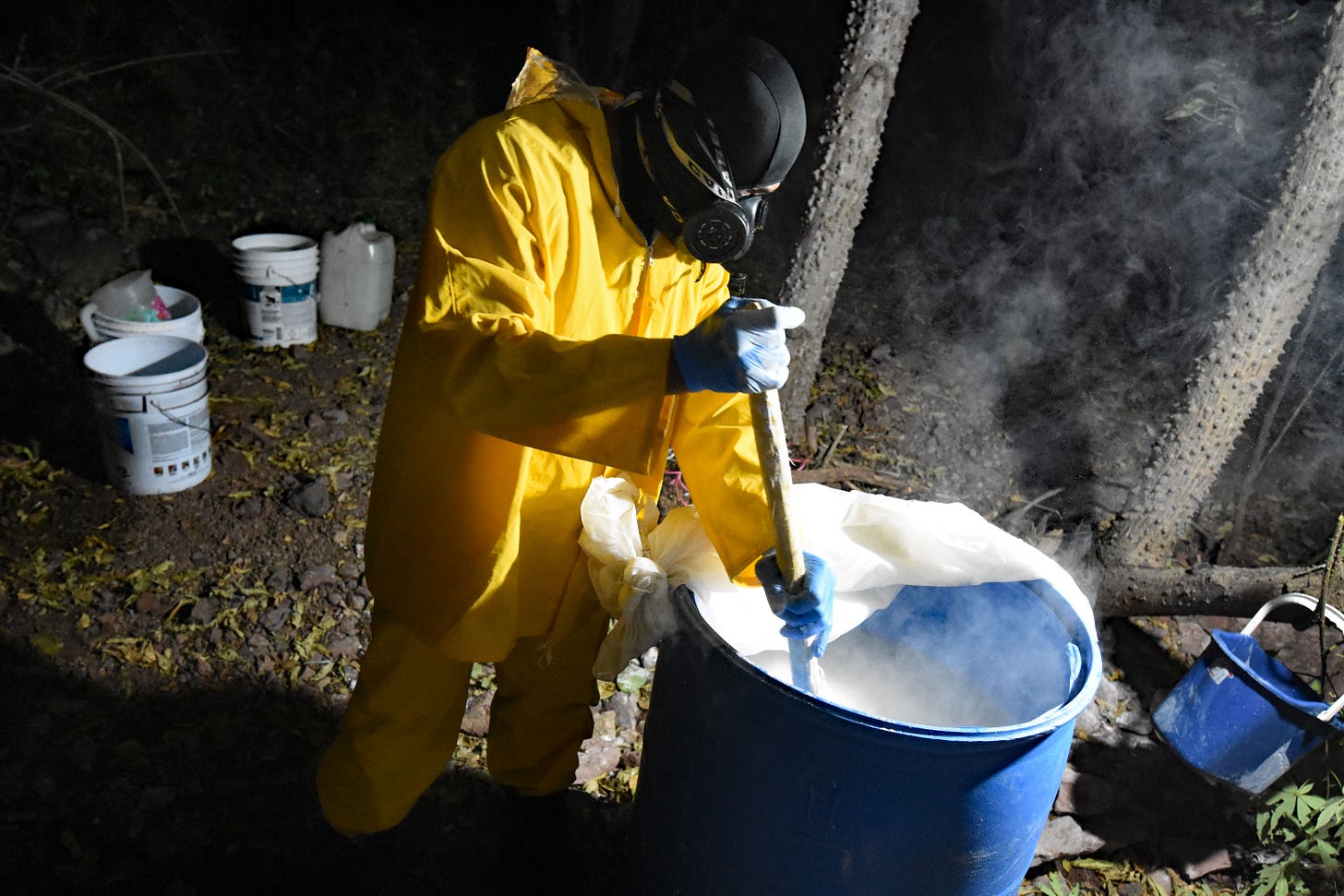


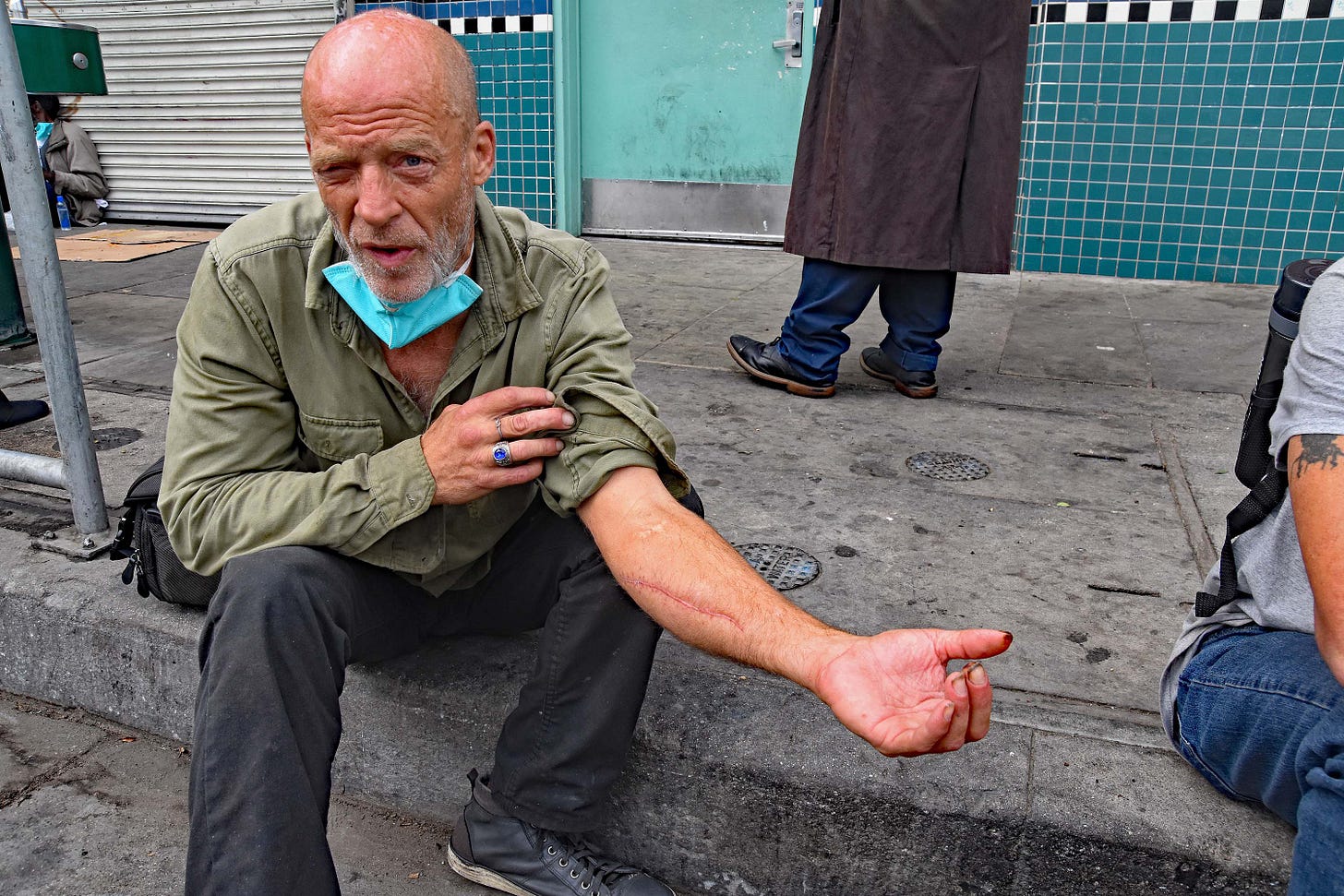

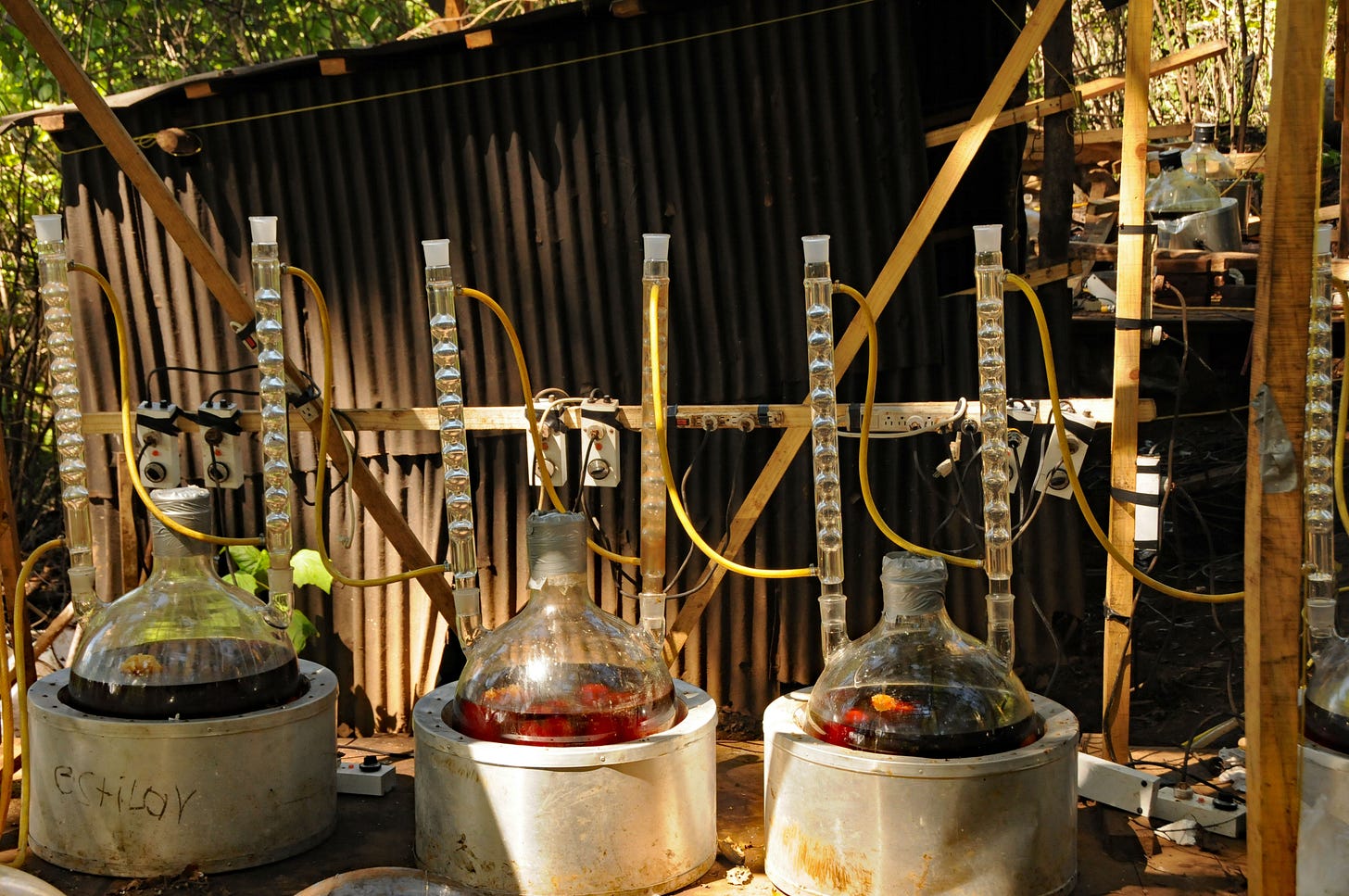
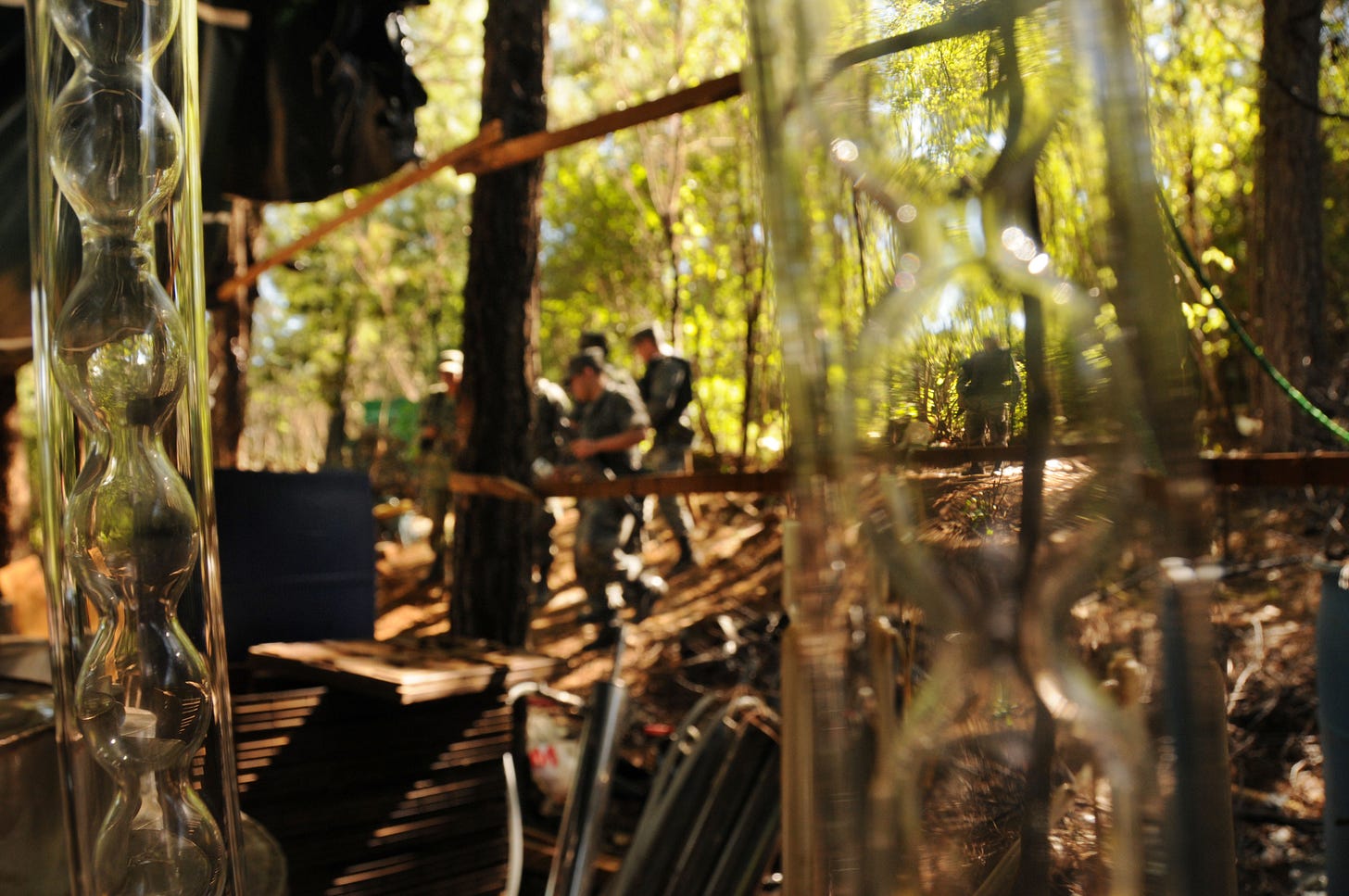


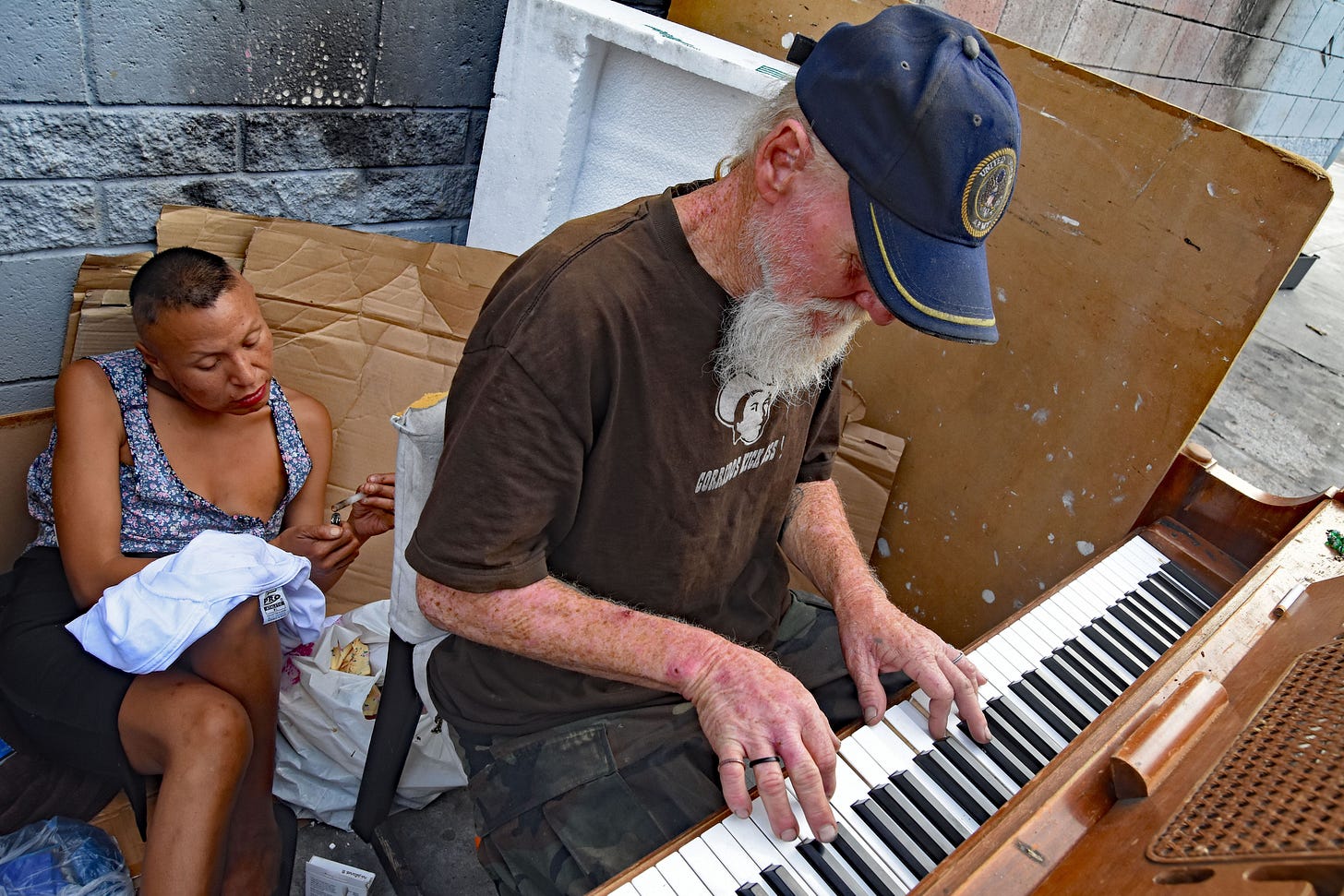
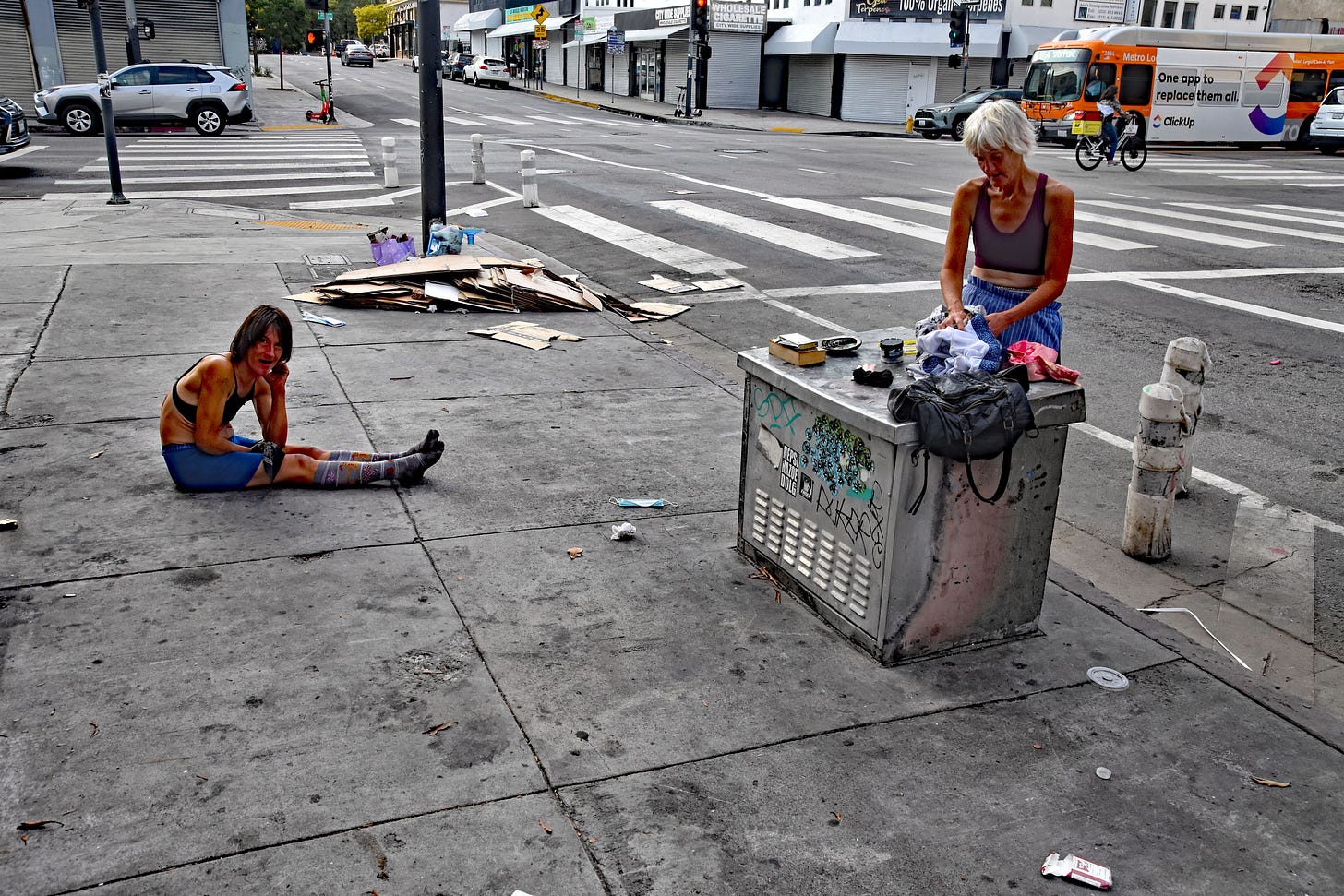
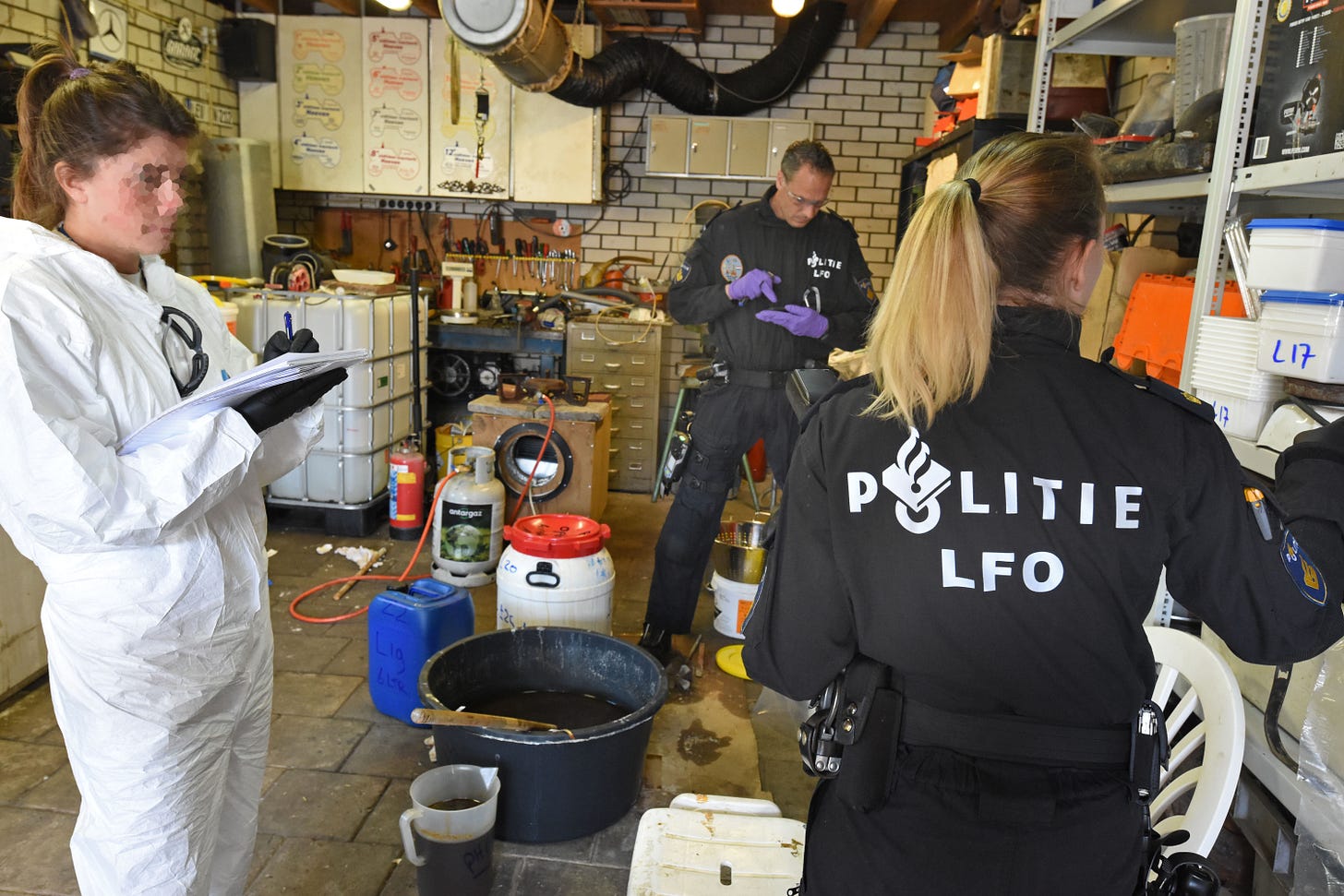
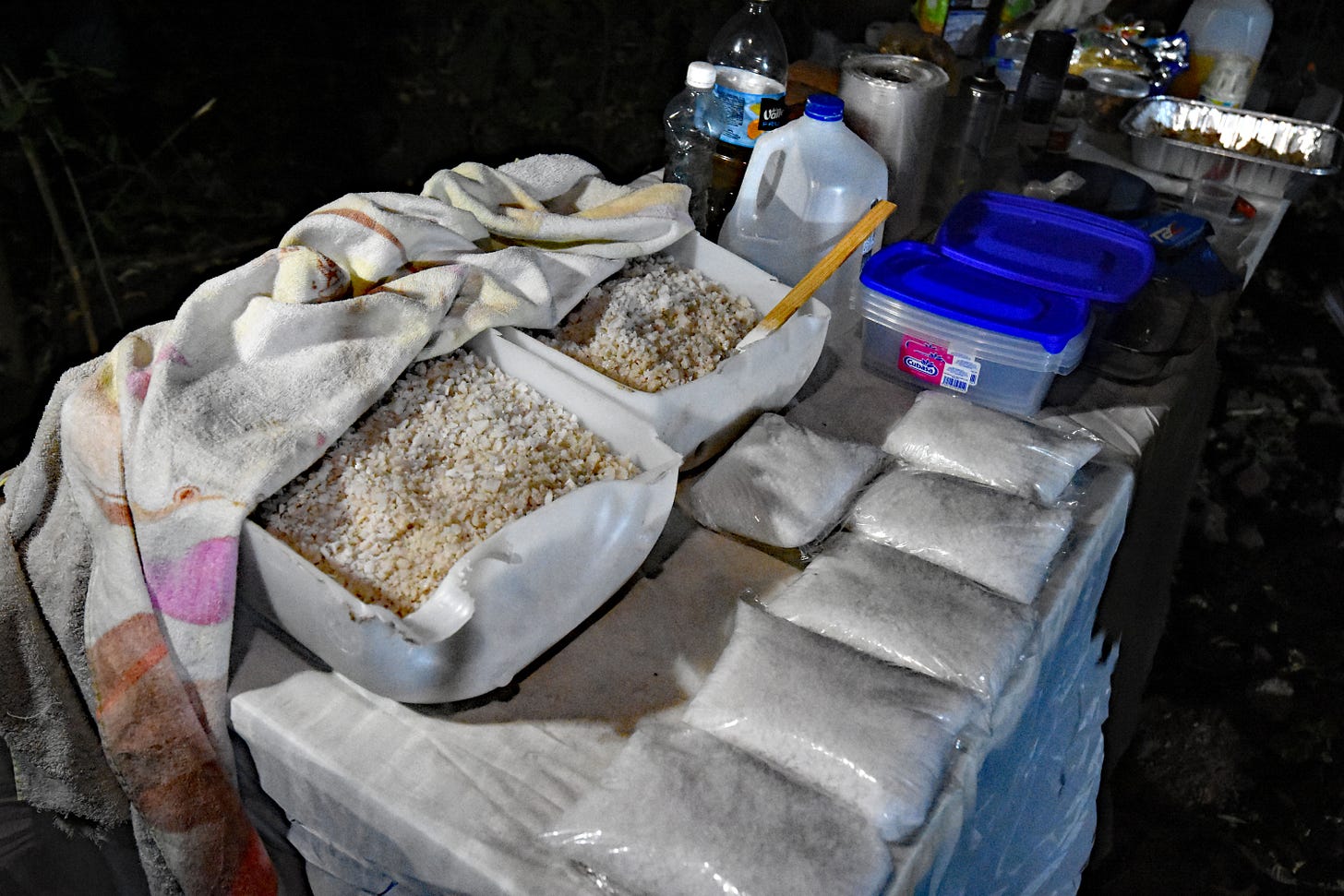
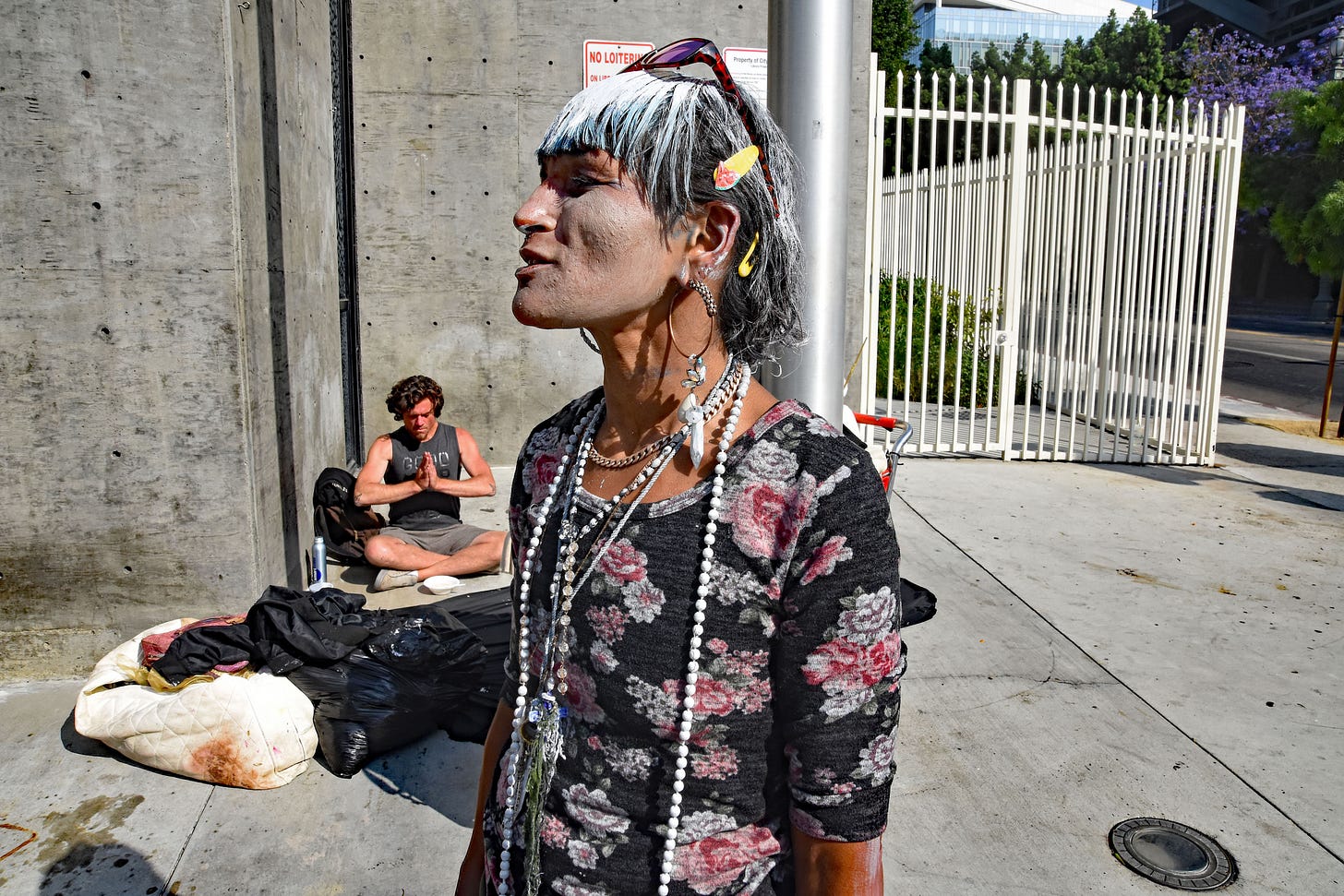
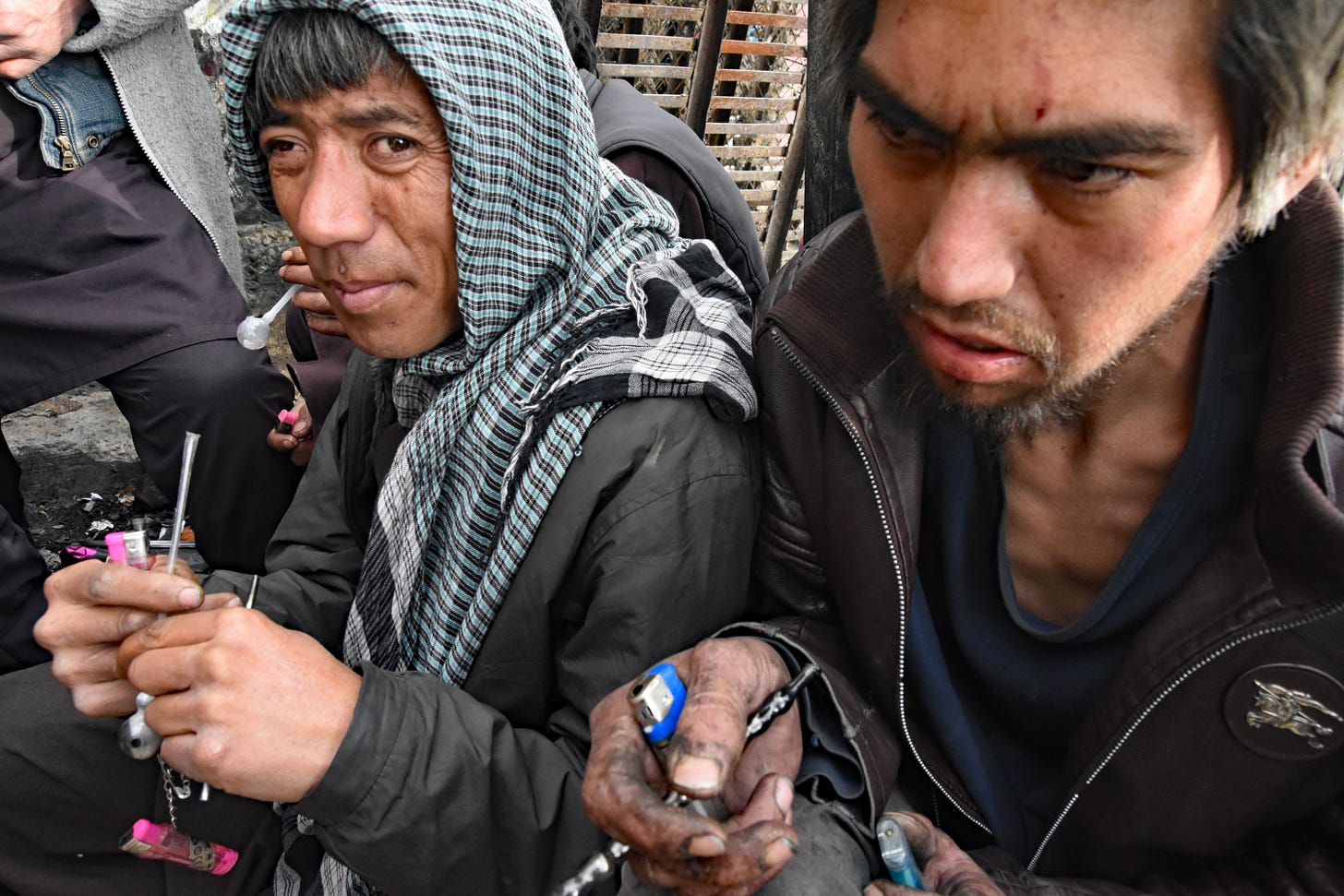
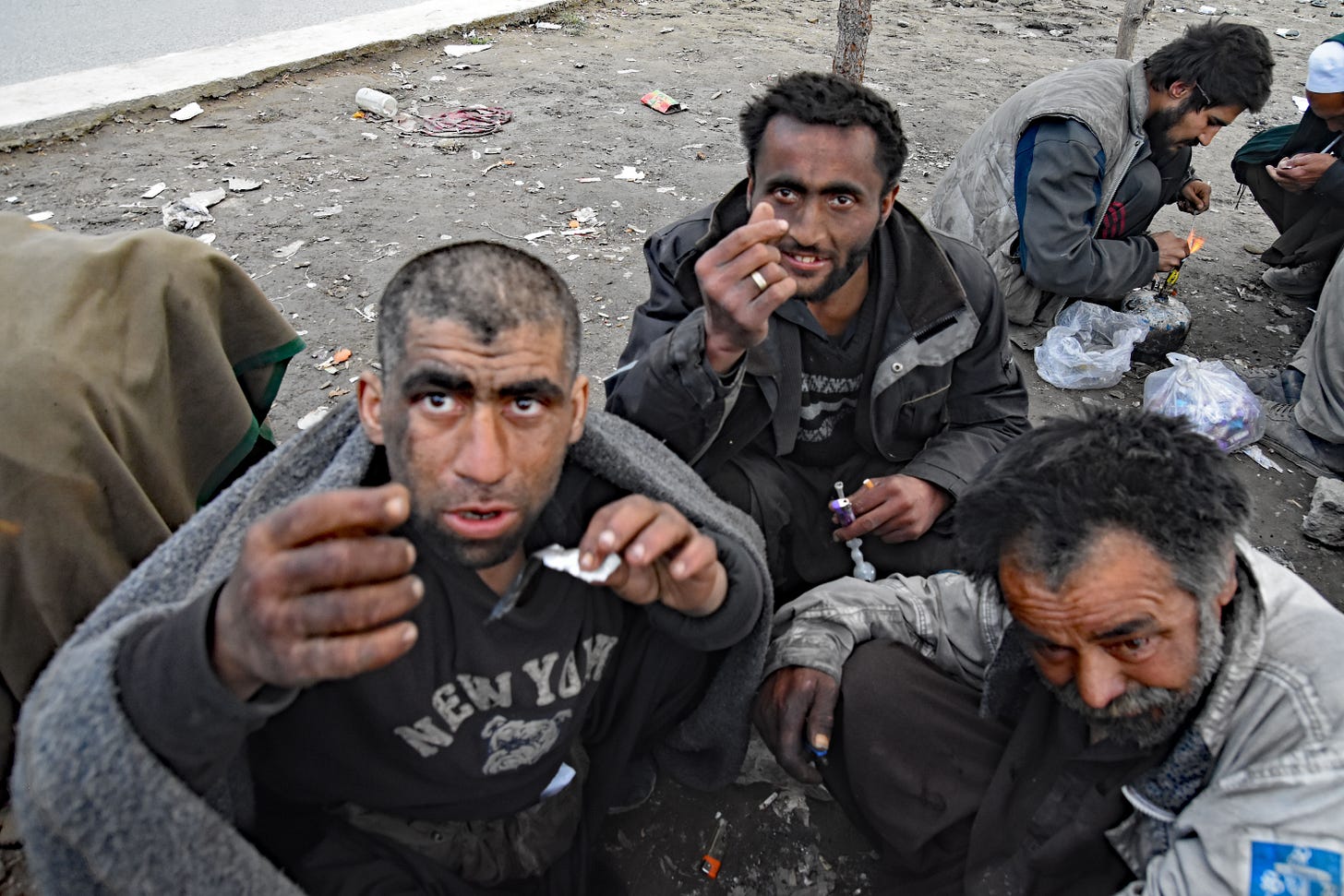
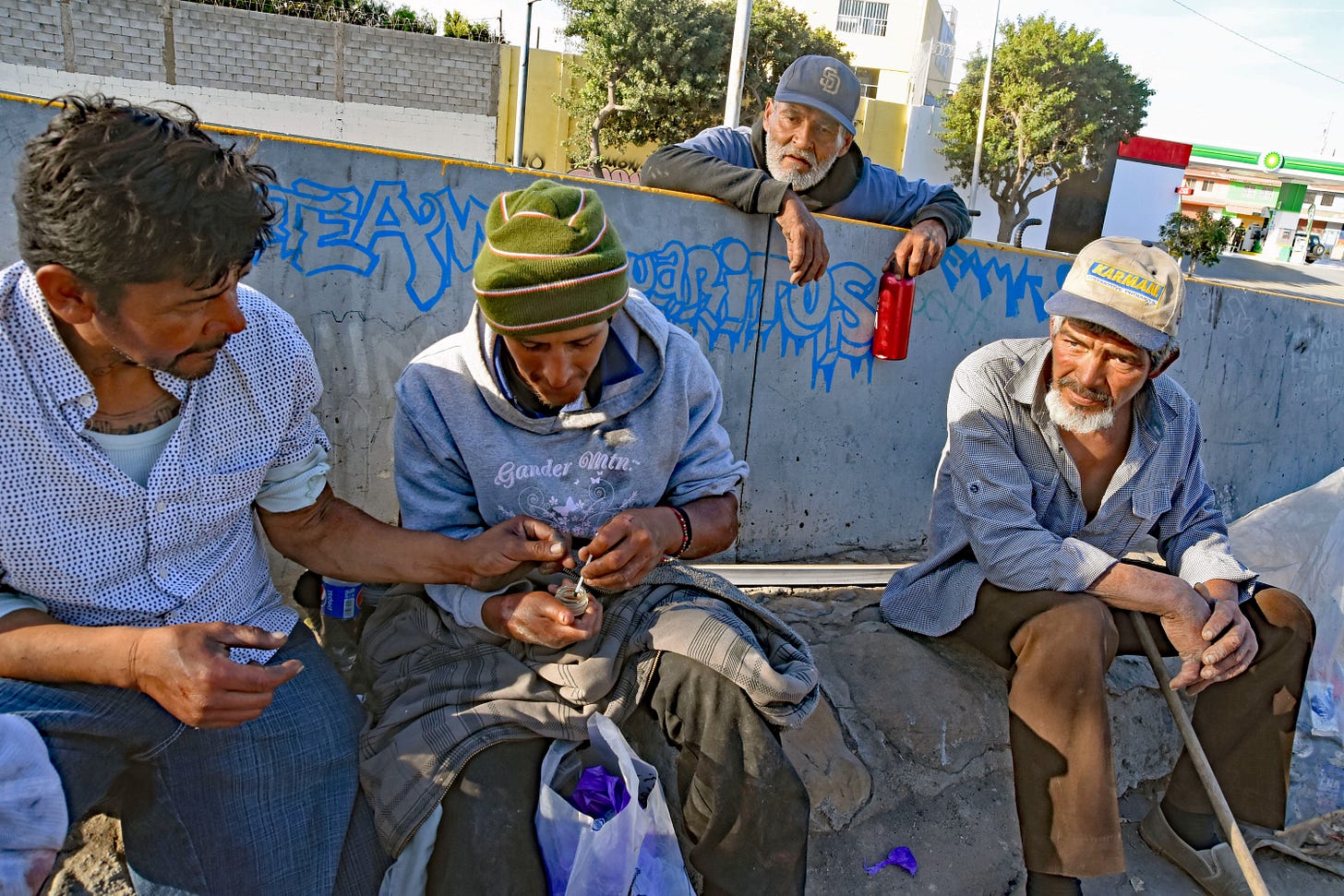
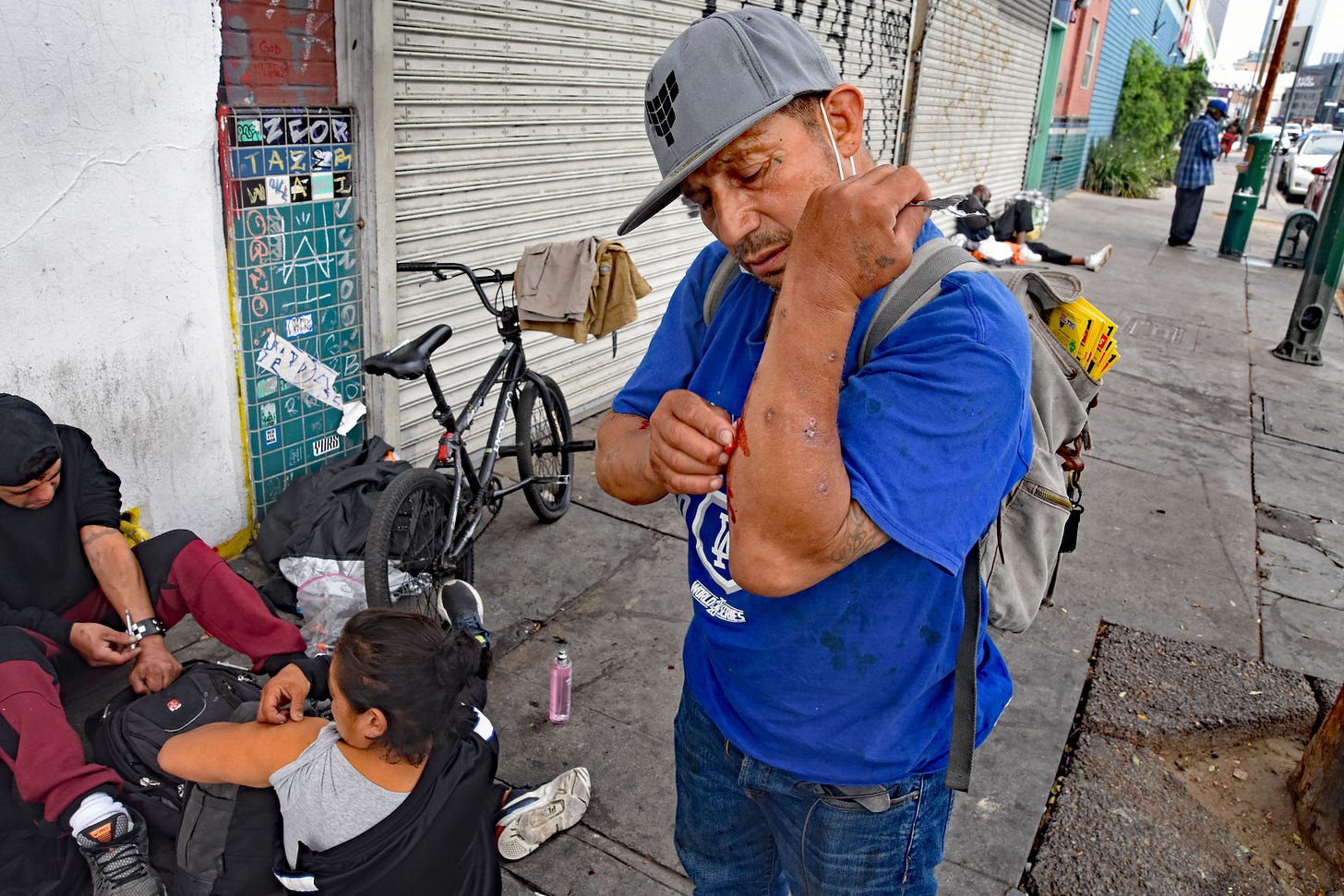


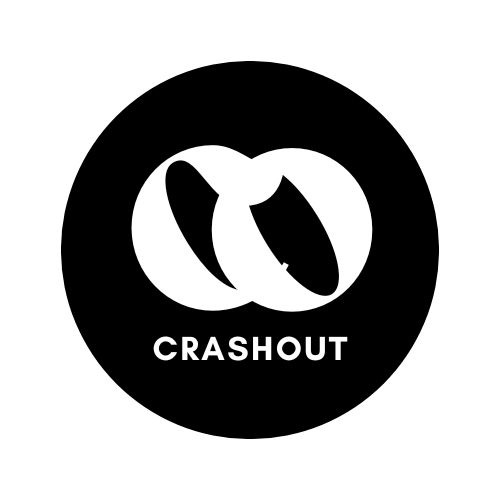
Hi Ioan. Your article hits home with me. My wife and I moved to downtown San Diego in 2006. Our community, East Village, had a brand-new baseball park, was undergoing gentrification and we wanted to be a part of its growth. We invested in a penthouse condo and began to greatly enjoy downtown living.
East Village was always a shit hole but we gambled it would get better. The ballpark replaced an industrial area adjacent to the lower socio-economic neighborhoods to the south and the gentrification of the Gaslamp district to the north.
We have dogs and they need to be walked several times a day. Our frequent walks taught us about our community. There were many empty-nesters like us, ambitious young adults and homeless people. At the time “Homeless” was a fair term as most had hit unfortunate times and were thriving to get back their lives. There was also a portion who were predators – the addicts and thugs. The existing laws at the time, gave us some control over the predators.
I had many pleasant encounters with our Homeless and was always eager to help them and then it changed. Our lawmakers decriminalized drugs and theft, legalized weed, and established zero bail.
Immediately, the homeless community morphed into a predatory community filled with criminals. Their numbers multiplied. Our secure buildings became their targets for shelter, and a means to exploit the property and residents to get goods for their next fix. As a 32-year veteran of law enforcement working the most dangerous criminals in the US and Mexico, I got into more action in East Village than ever on the job – and that’s walking 2 fat Pugs.
My spouse was victimized on several occasions while walking the dogs and I had several physical altercations with guns, knives, scissors, mop handles and other weapons. Over time, I became insensitive and even aggressive toward these predators. I was prepared for battle whenever exiting our building. Drug usage and other nasty habits were “in your face.” The police were stripped of their tools to enforce these nasty habits and it continued to deteriorate. The good people of our community were no longer the priority and the progressives and liberals continued to decriminalize and coddle the predators.
Having two children who serve with the San Diego Police Department, they begged us to leave East Village. It became the most dangerous area of the city. We finally left our dream condo by the ballpark for a more modest but safer community.
Living among this highly dysfunctional, transient and predatory population you realize that housing or providing free meals and shelter is not the solution. They just keep coming once you provide something. They require a highly structured, and secure rehabilitation camp away from functioning communities where they can get regular meals and services. They must be removed from our cities! They need to be held accountable. They will not seek help on their own and our good citizens must be the priority. This is what it has come to in California.
Great article. We used to say meth was a drug for Americans made by Americans when the production was domestic. Now, the majority of meth is made in Mexican super labs. Homelessness is big business in California ,people are making a lot of money solving he issue. The more money spend the larger it becomes. Also a problem are the advocates like Bales who says any housing without granite countertops is unacceptable. Lastly, the homeless population proved covid was a hoax as it did not put a dent in the numbers for a virus that was supposed to be so "deadly"